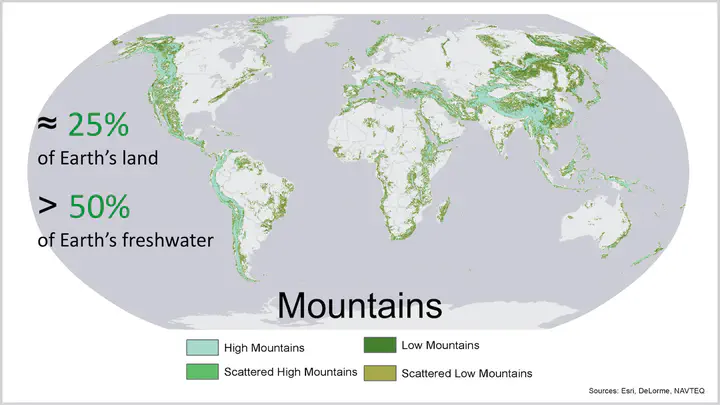Mountain Hydrology Research
 Mountains distribution around the world
Mountains distribution around the world
Our Mountain Hydrology Research Group has been established in August 2023 at Montana State University.
Mountains occupy approximately 25% of the Earth’s land area, and more than 50% of the Earth’s freshwater comes from mountain meltwater and runoff. As a result, mountains and highlands are often referred to as the world’s natural “water towers.” Despite this, our understanding of mountain hydrology is still very limited. Across the globe, nearly every region grapples with water-related challenges of varying degrees. Wide-spread drought, increased populations, flashier floods, and environmental requirements all strain existing water resources and their management. For example, the Colorado River basin has been overdrafted for decades. Its major reservoirs, Lake Mead and Lake Powell, have been steadily declining, threatening 40 million people in the West with a water supply crisis [1]. Following the crisis, a substantial number of discussions and research initiatives have been undertaken regarding the Colorado River basin [2, 3, 4].
The Colorado River is not an exception in this regard. While Canada is the world’s third most water-abundant nation, the Prairies - Alberta, Saskatchewan, and Manitoba - are prone to both flooding and drought [5, 6]. Their water supply depends on how much snow collects in the Rockies – known as the region’s “water towers” - and how quickly it runs off as it melts. Warmer temperatures are causing mountain snow and ice to melt earlier, increasing the likelihood of summertime water shortages. For example, record high temperatures and a record fire season have been hitting Canada at the same time in the summer of 2023 [7]. The combination is forcing Canadians to re-engineer their relationship with wildfires and plan for a future where more wildfires are part of the new reality. Nevertheless, the precise repercussions of this combination on water resources remain inadequately understood.

References
[1] Bland, Alastair (May 22, 2023). Colorado River deal: What does it mean for California? https://calmatters.org/environment/water/2023/05/colorado-river-states-agreement/
[2] Ge, S., J. Silverstein, J. Eklund, P. Limerick, and D. Stewart (2023), Fixing the flawed Colorado River Compact, Eos, 104, https://doi.org/10.1029/2023EO230232. Published on 16 June 2023.
[3] Palmer, J. (2023), Biden administration considers unprecedented solution to Colorado River crisis, Eos, 104, https://doi.org/10.1029/2023EO230151. Published on 12 April 2023.
[4] Palmer, J. (2023), Agriculture 3.0: Preparing for a drier future in the Colorado River Basin, Eos, 104, https://doi.org/10.1029/2023EO230247. Published on 5 July 2023.
[5] Canadian Water Network. (April 13, 2023). Does Canada need to worry about climate and water scarcity? https://cwn-rce.ca/2023/04/13/does-canada-need-to-worry-about-climate-and-water-scarcity/
[6] Nickel, Rod and Lewis, Jeff (September 2, 2021). Rocky Mountain dry: Canada’s waning water supply sows division in farm belt https://www.reuters.com/world/americas/rocky-mountain-dry-canadas-waning-water-supply-sows-division-farm-belt-2021-09-02/
[7] Clifford, Catherine (July 13, 2023). Record heat meets record wildfires in Canada, and scientists say this is the new reality https://cnb.cx/44rE1qW